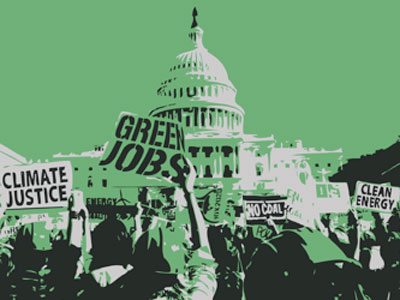Ah, the party planner’s problem. You send out an invitation, and what happens if they all say yes?
I’m just back from today’s magnificent civil disobedience outside the Capitol power plant. It began around 1 p.m., with the morning’s snow still swirling—and out of the snow hundreds and then thousands of people arriving, signs in hand, many wearing green hardhats, all ready to go for a march. And what a march—down a few blocks off Capitol Hill into a strange semi-wasteland of overpasses, newly built luxury condos now unoccupied in the housing bust—and a big ugly power plant.
We marched a lap around the complex, dropping off color-coded contingents at each of the five gates—green flags with several hundred people at the first, red at the second. The mass of us gathered outside the main gate, before a small stage, and then listened to half the most important folk in the environmental movement, from Gus Speth to Wendell Berry to young indigenous activists to some guy named Jim Hansen. Cheering, singing, dancing, shivering.
The only problem was, too many people. We simply overwhelmed the police, who were prepared to arrest 500 but not ten times that many. And so they simply refused. Short of actually assaulting cops, which no one had the slightest interest in, it was simply impossible to get arrested. We were all risking it—we were standing where we weren’t supposed to for hours on end. And we shut down the plant for the afternoon.
Not only that, of course, but since Nancy Pelosi and Harry Reid had actually caved in last week, announcing they’d end 103 years of burning coal in the plant and convert it to natural gas, there was no obstacle to declaring victory, utter and complete.
I was the slightest bit disappointed, because I’d looked forward to eating out for a long time on the story of sharing a cell with Berry and Hansen and Terry Tempest Williams and Janisse Ray and Kathy Mattea and all the other good folks who were out there standing their ground. It would have been one hell of a stretch behind bars, and we could have written some kind of great letter from jail.
But much better to see the wide smiles on the faces of the thousands of college kids who made up much of the crowd. The kind of wide smiles that come with saying: ‘so this is how it works.’ It’s not impossible. All it takes is a movement, which now we’ve got to build.















